| View previous topic :: View next topic |
| Author |
Message |
kuuan


Joined: 14 Jan 2008
Posts: 4569
Location: right now: Austria
Expire: 2014-12-26
|
 Posted: Sat Dec 05, 2009 12:09 am Post subject: Posted: Sat Dec 05, 2009 12:09 am Post subject: |
 |
|
kuuan wrote:
 WOW WOW 
thank you no-X!
_________________
my photos on flickr: https://www.flickr.com/photos/kuuan/collections |
|
| Back to top |
|
 |
dakoo


Joined: 08 Mar 2008
Posts: 603
|
 Posted: Sat Dec 05, 2009 6:59 am Post subject: Posted: Sat Dec 05, 2009 6:59 am Post subject: |
 |
|
dakoo wrote:
This is very well made one..
Excellent. Finally i am able to understand the comparisions ...
Thanks a lot..
_________________
Yashica ML 2.4/24, ML 2.4./28,
Zeiss Distagon 35/1.4, Planer 1.4/50, Planer 1.7/50,
SMC Tak 1.4/50,Tessar 2.8/50, Jupiter2/85
CZJ 4/135; Pentacon 4/200
Canon Tns 24/3.5
|
|
| Back to top |
|
 |
aoleg


Joined: 22 Feb 2008
Posts: 1387
Location: Berlin, DE
|
 Posted: Sat Dec 05, 2009 8:52 am Post subject: Posted: Sat Dec 05, 2009 8:52 am Post subject: |
 |
|
aoleg wrote:
Well done - a useful piece!
_________________
List of lenses |
|
| Back to top |
|
 |
MF-addicted


Joined: 11 Mar 2009
Posts: 803
Location: Stuttgart (Germany)
|
 Posted: Sat Dec 05, 2009 9:28 am Post subject: Posted: Sat Dec 05, 2009 9:28 am Post subject: |
 |
|
MF-addicted wrote:
Thank you for the provided details.
Informations about the Steinheil Cassars and others would be helpful, too.
A well honoured work you have done with providing your list.

_________________
EOS 5D MK II, EOS 5D Classic, EOS 400D --------------------------------------------------------------------------------------------------------------------------------
Canon FD to EOS converted: FD 1,4/24 asph, FD 2,8/300 L
Carl Zeiss Jena:Pancolar 2/50, black Biotar 2/5,8cm 17bl., slim Biotar 1,5/7,5cm 18bl., Pancolar 1,8/80mm, Sonnar 3,5/135, Triotar 4/135
Carl Zeiss: Distagon 4/18T*, Distagon 1,4/35 HFT, Planar 1,4/50 T*, Vario-Sonnar 3,4/35-70 T*,Vario-Sonnar 4,5-5,6/100-300 T*
Leitz: Elmarit-R 2.8/28 E55 II, Summicron-R 35 I, Elmarit-R Wetzlar 2.8/35 E55 II, Summicron-R 2/50 Wetzlar I, Macro Elmarit-R 2.8/60 I, Summicron-R 2/90 E55 I, Elmarit-R 2,8/90 I, Elmarit-R Wetzlar 2,8/135 I, Elmarit-R 2.8/180 Wetzlar E67 II, Vario Elmar 4/70-210 E60, MR Telyt-R 8/500
Schneider: Xenar 2.8/50
Russian: Industar 50-2, Industar 61,Helios-44-1 2/58mm,Helios-44-2 2/58mm, MC 3M-5CA 8/500
Meyer: Pentacon 3,5/30, Domiplan 2,8/50, Trioplan 2,9/50, Trioplan 3,5/75, Trioplan 2,8/100, Orestor 2,8/135mm, Orestegon 4/200
ISCO: Westron 2,8/35, Westron 3,5/35, Tele-Westanar 3,5/135, Tele-Westanar 4/180
Yashica: ML 15, ML 21, ML 24, ML 28, ML 35, ML 100/3.5 Macro,
Nikon: Nikkor AI 2,0/24, Nikkor AIS 2,0/28, Nikkor Ai 1,8/50, Nikkor-P (Sonnar) 2,5/105 silver, Nikkor-P (Gauss) 2,5/105 black
Steinheil Cassar 3,5-4,5/75 VL, Quinar 3,5/85, Culminar 4,5/105, Culminar 4,5/135, Auto-D Tele Quinar 2,8/135
Tomioka Tomioka - Cosinon 1,2/55, Tomioka - Revuenon 1,4/55
Voigtländer: Septon 2/50
Others: Officine Galileo Ingra 3,5/5cm, Wilon 4,5/75, Dallmeyer 4,5/4", Bonotar 4,5/105,
Lenses for sale, please contact via PM: None at the moment
|
|
| Back to top |
|
 |
BRunner

Joined: 29 Jul 2009
Posts: 705
Location: Czech Republic
|
 Posted: Sat Dec 05, 2009 1:51 pm Post subject: Posted: Sat Dec 05, 2009 1:51 pm Post subject: |
 |
|
BRunner wrote:
Hi no-x, than you for helpful information. What about the Tairs? I think, they are Triplets too.
Tair-2/3
Tair-11 |
|
| Back to top |
|
 |
estudleon


Joined: 15 May 2008
Posts: 3754
Location: Argentina
|
 Posted: Sat Dec 05, 2009 1:58 pm Post subject: Posted: Sat Dec 05, 2009 1:58 pm Post subject: |
 |
|
estudleon wrote:
Excelent!!!!
It´s in the same level of your comparision of 35 mm lenses, pancolar, 135 mm, etc.
Now I can see why the rendering of my mamiya TL 2,8/135 mm lens (ernostar) is so different than the CZJ 2,5/135 sonnar one.
But I have a doubt :
1- The mamiya 2,8/135 first version (TL) is the ernostar schame
See the link posted in http://freenet-homepage.de/stauber/mamiya-nc/m42_mamiya_135_2.8_tl.htm
2- The mamiya 2,8/135- 2nd version -DTL- had the same schame than the first version.
See http://freenet-homepage.de/stauber/mamiya-nc/m42_mamiya_135_2.8_dtl.htm
3- The mamiya 2,8/135 3rd version is the SX had the same design (4/4) that the 2nd.
See http://freenet-homepage.de/stauber/mamiya-nc/m42_mamiya_sx_135_2.8.htm
4- But the rolleinar (made by mamiya) 2,8/135 isn't the TL, DTL or SX version
Becuase it's a sonnar design??? (4/4)
See http://www.taunusreiter.de/Cameras/Rollei_QBM_Schneider_dt.html#Rolleinar
5- and Rolleinar is not the last mamiya CS 2,8/135 lens (5/4).
See http://freenet-homepage.de/stauber/mamiya-nc/cs_135_2.8.htm
Rolleinar-Mamioya isn't clear to me.
Rino.
_________________
Konica 2,8/100
CZJ: 4/20, 2,4/35, 1,8/50 aus jena, 3,5/135MC, Pentacon 1,8/50
Pentax S-M-C-1,4/50
Helios 44-3
Mamiya 2,8/135
Misc. : jupiter 9
Stuff used:
A) SRL
Alpa 10 D - kern macro Switar 1,9/50 -black, Kilffit apochromat 2/100.
Asahi pentax spotmatic super takumar 1,4/50
Contaflex super B tessar 2,8/50 Pro-tessar 115
Leica R3 electronic summicron 2/50 elmarit 2,8/35
Konica Autoreflex 3 (2 black and chrome one), TC, T4. 2,8/24, 3,5/28 not MC and MC, 1,8/40, 1,4/50, 1,7/50 MC and not MC, 1,8/85, 3,2/135, 3,5/135, 4/200
Minolta XG9 2,8/35, 2/45, 3,5/135
Nikkormat FTn 1,4/50, 2,8/135
Fujica ST 801, 605, 705n. 3,5/19, 1,4/50, 1,8/55, 4/85, 3,5/135.
Praktica MTL 5 and a lot of M42 lenses.
Voigtlander. Bessamatic m, bessamatix de luxe, bessamatic cs, ultramatic and ultramatic cs.
Skoparex 3,5/35, skopagon 2/40, skopar 2,8/50, skopar X 2,8/50, super lanthar (out of catalogue) 2,8/50, dinarex 3,4/90, dinarex 4,8/100, super dinarex 4/135, super dinarex 4/200, zoomar 2,8/36-83, portrait lens 0, 1 and 2. Curtagon 4/28 and 2,8/35
Canon AV1, 1,8/50
Rolleiflex SL35 and SL35 E. 2,8/35 angulon, 2,8/35 distagon, 1,4/55 rolleinar, 1,8/50 planar, 4/135 tessar, 2,8/135 rolleinar, x2 rollei, M42 to rollei adap.
Etc.
RF
Yashica Minister III
Voightlander Vito, vitomatic I, Vito C, etc.
Leica M. M2, M3 (d.s.) and M4. Schenider 3,4/21, 2/35 summaron 2,8/35 (with eyes). Summicron 2/35 (8 elements with eyes), 2/35 chrome, 2/35 black, 1,4/35 pre asph and aspheric - old -, 2/40 summicron, 2,8/50 elmar, 2/50 7 elements, 2/50 DR, 2/50 - minolta version, 1,4/50 summilux 1966 version, 1,4/75 summilux, 2/90 large version, 2/90 reduced version of 1987, 2,8/90 elmarit large version, 4/135 elmar. |
|
| Back to top |
|
 |
no-X


Joined: 19 Jul 2008
Posts: 2495
Location: Budejky, Czech Republic
|
 Posted: Sat Dec 05, 2009 3:48 pm Post subject: Posted: Sat Dec 05, 2009 3:48 pm Post subject: |
 |
|
no-X wrote:

4/4 construction is typical Ernostar. Typical sign of Sonnar is (at least one) cemented triplet:
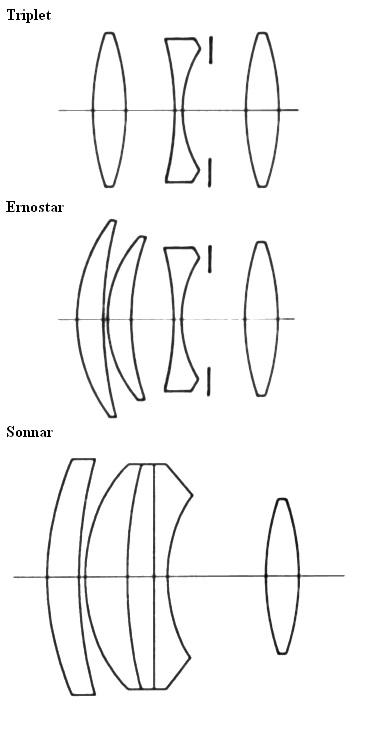
(while Primoplan is Ernostar with cemented doublet instead of the 2nd element)
These Rolleinars were manufactured by Mamiya and because of that I mentioned "Mamiya-Rolleinar" in the list.
_________________
(almost) complete list of Helios lenses |
|
| Back to top |
|
 |
estudleon


Joined: 15 May 2008
Posts: 3754
Location: Argentina
|
 Posted: Sat Dec 05, 2009 4:18 pm Post subject: Posted: Sat Dec 05, 2009 4:18 pm Post subject: |
 |
|
estudleon wrote:
Yes, NoX
But did you note the following:
The second, thick element of the rolleinar (same as the present in the sonnars 135 lenses), is more similar to the sonnar 2nd and 3rd cemented elements (in only one element) than to the 2nd ans 3rd elements in the ernostar?
The ernostar didn't have a thick 2nd element.
Rino.
_________________
Konica 2,8/100
CZJ: 4/20, 2,4/35, 1,8/50 aus jena, 3,5/135MC, Pentacon 1,8/50
Pentax S-M-C-1,4/50
Helios 44-3
Mamiya 2,8/135
Misc. : jupiter 9
Stuff used:
A) SRL
Alpa 10 D - kern macro Switar 1,9/50 -black, Kilffit apochromat 2/100.
Asahi pentax spotmatic super takumar 1,4/50
Contaflex super B tessar 2,8/50 Pro-tessar 115
Leica R3 electronic summicron 2/50 elmarit 2,8/35
Konica Autoreflex 3 (2 black and chrome one), TC, T4. 2,8/24, 3,5/28 not MC and MC, 1,8/40, 1,4/50, 1,7/50 MC and not MC, 1,8/85, 3,2/135, 3,5/135, 4/200
Minolta XG9 2,8/35, 2/45, 3,5/135
Nikkormat FTn 1,4/50, 2,8/135
Fujica ST 801, 605, 705n. 3,5/19, 1,4/50, 1,8/55, 4/85, 3,5/135.
Praktica MTL 5 and a lot of M42 lenses.
Voigtlander. Bessamatic m, bessamatix de luxe, bessamatic cs, ultramatic and ultramatic cs.
Skoparex 3,5/35, skopagon 2/40, skopar 2,8/50, skopar X 2,8/50, super lanthar (out of catalogue) 2,8/50, dinarex 3,4/90, dinarex 4,8/100, super dinarex 4/135, super dinarex 4/200, zoomar 2,8/36-83, portrait lens 0, 1 and 2. Curtagon 4/28 and 2,8/35
Canon AV1, 1,8/50
Rolleiflex SL35 and SL35 E. 2,8/35 angulon, 2,8/35 distagon, 1,4/55 rolleinar, 1,8/50 planar, 4/135 tessar, 2,8/135 rolleinar, x2 rollei, M42 to rollei adap.
Etc.
RF
Yashica Minister III
Voightlander Vito, vitomatic I, Vito C, etc.
Leica M. M2, M3 (d.s.) and M4. Schenider 3,4/21, 2/35 summaron 2,8/35 (with eyes). Summicron 2/35 (8 elements with eyes), 2/35 chrome, 2/35 black, 1,4/35 pre asph and aspheric - old -, 2/40 summicron, 2,8/50 elmar, 2/50 7 elements, 2/50 DR, 2/50 - minolta version, 1,4/50 summilux 1966 version, 1,4/75 summilux, 2/90 large version, 2/90 reduced version of 1987, 2,8/90 elmarit large version, 4/135 elmar. |
|
| Back to top |
|
 |
no-X


Joined: 19 Jul 2008
Posts: 2495
Location: Budejky, Czech Republic
|
 Posted: Sat Dec 05, 2009 11:30 pm Post subject: Posted: Sat Dec 05, 2009 11:30 pm Post subject: |
 |
|
no-X wrote:
The thickness depends on focal length and speed of the particular lens. The longer focal length, the thicker element. The triplet and ernostar in the picture examples are valid for standard lenses. Basic Ernostar is described as a lens consisting of two positive elements (meniscus), one negative element and one positive element at the end of optical block.
Despite many lenses are marketed as Sonnars, they are based on Ernostar designs and even the patent descriptions call them Ernostars.
Anyway, here is the rest...
double-gauss:
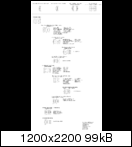
triplets:
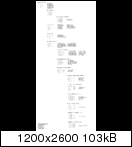
hybrid designs:
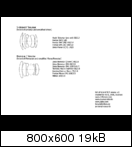
_________________
(almost) complete list of Helios lenses |
|
| Back to top |
|
 |
aoleg


Joined: 22 Feb 2008
Posts: 1387
Location: Berlin, DE
|
 Posted: Sun Dec 06, 2009 2:00 am Post subject: Posted: Sun Dec 06, 2009 2:00 am Post subject: |
 |
|
aoleg wrote:
I'd like to suggest a few lenses to add to your list.
1. Nikkor 135/3.5 (pre-Ai) falls into "Sonnar (simplified, 4 elements)"
http://www.mir.com.my/rb/photography/companies/nikon/nikkoresources/6070nikkor/telephoto/135mm.htm
2. Nikkor 135/3.5 (Ai, Ai-S), Nikkor-Q 135/2.8 fall into "Ernostar"
http://www.mir.com.my/rb/photography/companies/nikon/nikkoresources/135mmnikkor/index.htm
3. Nikkor pre-Ai and Ai 180/2.8, Leitz Elmarit 180/2.8 are... well, they are Sonnars, but yet another type; this optical construction was shared by many 135mm and 180mm lenses:
http://www.mir.com.my/rb/photography/companies/nikon/nikkoresources/late70nikkor/telephoto/180mm.htm
3. Nikkor pre-Ai 85/1.8 is "Biotar / Xenon"
http://www.mir.com.my/rb/photography/companies/nikon/nikkoresources/preAI70/85mm.htm
4. Nikkor Ai, Ai-S 85/2 are "5-element Takumar (hybrid of Ernostar and simplified Ultron"
http://www.mir.com.my/rb/photography/companies/nikon/nikkoresources/85mmnikkor/85mm2.htm
_________________
List of lenses |
|
| Back to top |
|
 |
rawhead


Joined: 09 Feb 2009
Posts: 1525
Location: Boston, MA
Expire: 2014-04-29
|
 Posted: Sun Dec 06, 2009 5:19 am Post subject: Posted: Sun Dec 06, 2009 5:19 am Post subject: |
 |
|
rawhead wrote:
Hey no-x, what an awesome body of work you're creating here. Bravo. It is invaluable.
One thing I noticed; I thought that Volna-9 was Tessar design
http://www.luciolepri.it/lc2/marcocavina/articoli_fotografici/kiev_volna9/00_pag.htm
not double gauss?
_________________
Sony α7R, Pentax 67II, Kiev-60, Hasselblad 203FE, 903SWC, Graflex Norita 66, Mamiya M645 1000s, Burke & James 8x10, Graflex Pacemaker Speed Graphic (4x5 and 3x4), Century Graphic (2x3), R.B. Graflex Seried D, Rolleiflex SL66E, Rolleiflex 2.8C Xenotar, Mamiya C330f, a few M42, six P6, three OM, four Hasselblad, two Pentax 67, two Mamiya 645, one Noritar, and a sprinkle of EF. Oh, and an Aero Ektar and Leica Noctilux |
|
| Back to top |
|
 |
cooltouch


Joined: 15 Jan 2009
Posts: 9096
Location: Houston, Texas
|
 Posted: Sun Dec 06, 2009 7:58 am Post subject: Posted: Sun Dec 06, 2009 7:58 am Post subject: |
 |
|
cooltouch wrote:
Very nice of you to have made all this data available to us, no-X. I'm no optics expert, but it's always nice -- and valuable -- having this sort of reference.
I suppose I should mention this: I've recently been going through some of my old collections of photo-related publications, and I have some items that members here might find interesting. I have two different editions of Canon's An Introduction to the F-1, which has lens formula diagrams for all their FD lenses (as of 1977, my most recent copy), plus I have a copy of The Eyes of Nikon, which dates to sometime during the mid-80s, and it has lens formula diagrams for all Nikkors that were current at that time, plus I have Joseph Cooper's Nikon/Nikkormat Handbook and Minolta Handbook, both of which have lens formula diagrams for all the lenses produced by each manufacturer up to the dates of each of these publications (mid-70s). And I also have a copy of Osterloh's Leica M, which has some lens formula diagrams as well. His book probably dates to the mid-to-late 80s.
I've been giving this some thought for the past several days, and I think what I will do is digitize the lens formula data and drawings I have in these books. I can make them available to the members here, but the size of the file collections will be LARGE. And you'll have to allow me some time to do this because we're talking about hundreds of lenses.
Regardless of forum interest, I plan to do this anyway, since I like having this sort of information handy, and it will be easier to do comparisons across brands with image files than having to page through an assortment of different books.
_________________
Michael
My Gear List: http://michaelmcbroom.com/photo/gear.html
My Gallery: http://michaelmcbroom.com/gallery3/index.php/
My Flickr Page: https://www.flickr.com/photos/11308754@N08/albums
My Music: https://soundcloud.com/michaelmcbroom/albums
My Blog: http://michaelmcbroom.com/blogistan/ |
|
| Back to top |
|
 |
no-X


Joined: 19 Jul 2008
Posts: 2495
Location: Budejky, Czech Republic
|
 Posted: Sun Dec 06, 2009 11:03 am Post subject: Posted: Sun Dec 06, 2009 11:03 am Post subject: |
 |
|
no-X wrote:
rawhead: Relayer is all right. It is definately not Tessar. I took my Volna and counted reflections separately for front group and rear group:
front group: 6 reflections = 6 air/glass surfaces = 3 optical elements
rear group: 5 reflections = 4 air/glass surfaces + 1 cemented surface = 3 optical elements in 2 groups.
Thanks. I'm not into Nikon lenses, but I'll try to add these.
This is the same as Meyer/Pentacon 135/2.8 ("bokehmonster")... variation of Primoplan (=Ernostar with cemented doublet instead of 2nd element).
Btw. here are some interesting information (esp. for Asahi fans) I revealed during my search of old patents:
Patent for Asahi Takumar 24/3.5 (Pentax 24/3.5) lens:
Takumar 24/3.5:

patented scheme:
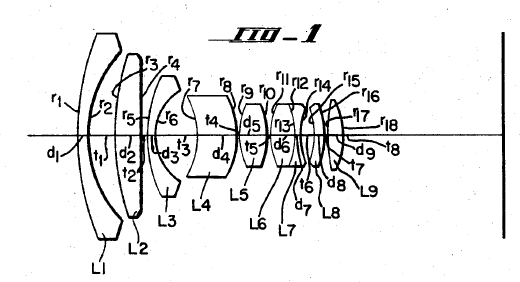
inventor: Yasuo Takahashi, Asahi Kogaku (patent number: 3545845)
Patent for Asahi Takumar 135/2.5 (version 1):
Takumar 135/2.5:
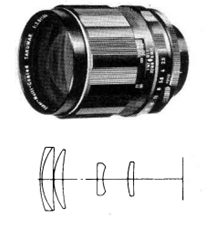
patented optical scheme:
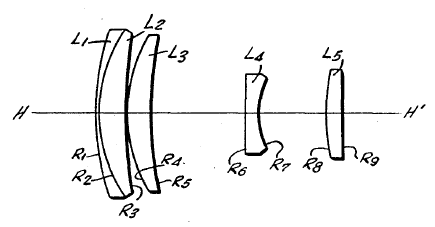
inventor: Yasuo Takahashi, Asahi Kogaku (patent number: 3459469)
Canon's copy-shop example #1
Asahi/Pentax 40/2.8 lens produced in 1976:

patent by Canon, 1978:
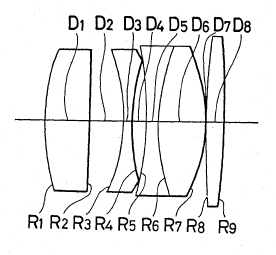

Canon's copy-shop example #2
Asahi 55/2.2 lens produced in 1957:

patent by Canon, 1958:
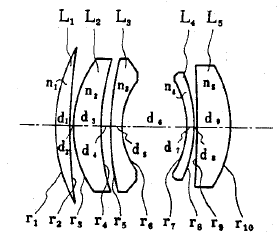
_________________
(almost) complete list of Helios lenses |
|
| Back to top |
|
 |
ChrisLilley


Joined: 01 Jan 2008
Posts: 1767
Location: Nice, France
|
 Posted: Sun Dec 06, 2009 2:13 pm Post subject: Posted: Sun Dec 06, 2009 2:13 pm Post subject: |
 |
|
ChrisLilley wrote:
Many thanks for the new set of drawings! Fascinating.
I guess the Nikkor 85/1.5 is the Nikkor-S 8.5cm f/1.5 rangefinder lens?
 
Would the Nikkor-S 5cm f/1.4 rangefinder lens also fall int he same category?
 
_________________
Camera (ˈkæ mə rə), n. Device for taking pictures in bright light
There are 10 kinds of people in the world: those who understand binary, and those who don’t. Key: Ai-P, Ai, Ai'ed, AiS
Camera: Nikon D90, D40, DK-21M eyepiece, ML-3 remote MF lenses: Nikkor 20mm f/4 K, AI'ed | N.K. Nikkor-N 24mm f/2.8 | Nikkor-N.C 24mm f/2.8 | Nikkor 28mm f/2.8 AiS late model | Арсенал (Arsenal) Мир-24Н (Mir-24N) 35mm f/2 | Cosina Voigtländer Ultron SL II 40mm f/2.0 | Micro-Nikkor 55mm f/2.8 AiS | Zoom-Nikkor 80-200 f/4.5 Ai | ЛЗОС (LZOS) Юпитер-9 (Jupiter-9) 85mm f/2 | Cosina Voigtländer APO-Lanthar 90mm f/3.5 SL | Nikkor-P 105mm f/2.5 pre-Ai, Ai'ed | Micro-Nikkor 105mm f/4 | Schneider Kreuznach Componon 105mm f/5.6 | Nikkor 135mm f/2.8, Ai'ed 1976 model | Nikkor 180mm f/2.8 ED AiS | Арсенал (Arsenal) ТЕЛЕАР-Н (Telear-n) 200mm f/3.5 | Nikkor 300 mm f/4.5 Ai (full equipment list) |
|
| Back to top |
|
 |
ChrisLilley


Joined: 01 Jan 2008
Posts: 1767
Location: Nice, France
|
 Posted: Sun Dec 06, 2009 2:23 pm Post subject: Posted: Sun Dec 06, 2009 2:23 pm Post subject: |
 |
|
ChrisLilley wrote:
Would this design fall into "Tele Takumar/ Enhanced Ernostar with 2 rear groups"? It looks just like your Tele Takumar/ Enhanced Ernostar category, with an additional rear element.
This is the Cosina Voigtländer APO-Lanthar 90mm f/3.5 SL

_________________
Camera (ˈkæ mə rə), n. Device for taking pictures in bright light
There are 10 kinds of people in the world: those who understand binary, and those who don’t. Key: Ai-P, Ai, Ai'ed, AiS
Camera: Nikon D90, D40, DK-21M eyepiece, ML-3 remote MF lenses: Nikkor 20mm f/4 K, AI'ed | N.K. Nikkor-N 24mm f/2.8 | Nikkor-N.C 24mm f/2.8 | Nikkor 28mm f/2.8 AiS late model | Арсенал (Arsenal) Мир-24Н (Mir-24N) 35mm f/2 | Cosina Voigtländer Ultron SL II 40mm f/2.0 | Micro-Nikkor 55mm f/2.8 AiS | Zoom-Nikkor 80-200 f/4.5 Ai | ЛЗОС (LZOS) Юпитер-9 (Jupiter-9) 85mm f/2 | Cosina Voigtländer APO-Lanthar 90mm f/3.5 SL | Nikkor-P 105mm f/2.5 pre-Ai, Ai'ed | Micro-Nikkor 105mm f/4 | Schneider Kreuznach Componon 105mm f/5.6 | Nikkor 135mm f/2.8, Ai'ed 1976 model | Nikkor 180mm f/2.8 ED AiS | Арсенал (Arsenal) ТЕЛЕАР-Н (Telear-n) 200mm f/3.5 | Nikkor 300 mm f/4.5 Ai (full equipment list) |
|
| Back to top |
|
 |
no-X


Joined: 19 Jul 2008
Posts: 2495
Location: Budejky, Czech Republic
|
 Posted: Sun Dec 06, 2009 2:28 pm Post subject: Posted: Sun Dec 06, 2009 2:28 pm Post subject: |
 |
|
no-X wrote:
| ChrisLilley wrote: |
| Would the Nikkor-S 5cm f/1.4 rangefinder lens also fall int he same category? |
Lovely Sonnars, both of them  I'll add them, too. I'll add them, too.
As for the Lanthar, I'm not sure. I don't have this lens. Is its optical block "fixed", or does the rear element stays in the same position during focusing?
_________________
(almost) complete list of Helios lenses |
|
| Back to top |
|
 |
ChrisLilley


Joined: 01 Jan 2008
Posts: 1767
Location: Nice, France
|
 Posted: Sun Dec 06, 2009 2:41 pm Post subject: Posted: Sun Dec 06, 2009 2:41 pm Post subject: |
 |
|
ChrisLilley wrote:
Does the Cosina Voigtländer Ultron 40mm f/2 fall into the Ultron group? It seems similar, but the second and third elements are different. 9also, the final element is aspherical).

_________________
Camera (ˈkæ mə rə), n. Device for taking pictures in bright light
There are 10 kinds of people in the world: those who understand binary, and those who don’t. Key: Ai-P, Ai, Ai'ed, AiS
Camera: Nikon D90, D40, DK-21M eyepiece, ML-3 remote MF lenses: Nikkor 20mm f/4 K, AI'ed | N.K. Nikkor-N 24mm f/2.8 | Nikkor-N.C 24mm f/2.8 | Nikkor 28mm f/2.8 AiS late model | Арсенал (Arsenal) Мир-24Н (Mir-24N) 35mm f/2 | Cosina Voigtländer Ultron SL II 40mm f/2.0 | Micro-Nikkor 55mm f/2.8 AiS | Zoom-Nikkor 80-200 f/4.5 Ai | ЛЗОС (LZOS) Юпитер-9 (Jupiter-9) 85mm f/2 | Cosina Voigtländer APO-Lanthar 90mm f/3.5 SL | Nikkor-P 105mm f/2.5 pre-Ai, Ai'ed | Micro-Nikkor 105mm f/4 | Schneider Kreuznach Componon 105mm f/5.6 | Nikkor 135mm f/2.8, Ai'ed 1976 model | Nikkor 180mm f/2.8 ED AiS | Арсенал (Arsenal) ТЕЛЕАР-Н (Telear-n) 200mm f/3.5 | Nikkor 300 mm f/4.5 Ai (full equipment list) |
|
| Back to top |
|
 |
no-X


Joined: 19 Jul 2008
Posts: 2495
Location: Budejky, Czech Republic
|
 Posted: Sun Dec 06, 2009 2:44 pm Post subject: Posted: Sun Dec 06, 2009 2:44 pm Post subject: |
 |
|
no-X wrote:
Yes, this is quite typical Ultron (basic Ultron: 1-1-1|2-1). I'd like to get this lens in M42 mount, but I have no luck...
_________________
(almost) complete list of Helios lenses |
|
| Back to top |
|
 |
ChrisLilley


Joined: 01 Jan 2008
Posts: 1767
Location: Nice, France
|
 Posted: Sun Dec 06, 2009 2:46 pm Post subject: Posted: Sun Dec 06, 2009 2:46 pm Post subject: |
 |
|
ChrisLilley wrote:
| no-X wrote: |
As for the Lanthar, I'm not sure. I don't have this lens. |
Okay. I do, so does Orio and Klaus.
| no-X wrote: |
| Is its optical block "fixed", or does the rear element stays in the same position during focusing? |
Its fixed (unit focusing). The whole block moves as one unit to focus.
_________________
Camera (ˈkæ mə rə), n. Device for taking pictures in bright light
There are 10 kinds of people in the world: those who understand binary, and those who don’t. Key: Ai-P, Ai, Ai'ed, AiS
Camera: Nikon D90, D40, DK-21M eyepiece, ML-3 remote MF lenses: Nikkor 20mm f/4 K, AI'ed | N.K. Nikkor-N 24mm f/2.8 | Nikkor-N.C 24mm f/2.8 | Nikkor 28mm f/2.8 AiS late model | Арсенал (Arsenal) Мир-24Н (Mir-24N) 35mm f/2 | Cosina Voigtländer Ultron SL II 40mm f/2.0 | Micro-Nikkor 55mm f/2.8 AiS | Zoom-Nikkor 80-200 f/4.5 Ai | ЛЗОС (LZOS) Юпитер-9 (Jupiter-9) 85mm f/2 | Cosina Voigtländer APO-Lanthar 90mm f/3.5 SL | Nikkor-P 105mm f/2.5 pre-Ai, Ai'ed | Micro-Nikkor 105mm f/4 | Schneider Kreuznach Componon 105mm f/5.6 | Nikkor 135mm f/2.8, Ai'ed 1976 model | Nikkor 180mm f/2.8 ED AiS | Арсенал (Arsenal) ТЕЛЕАР-Н (Telear-n) 200mm f/3.5 | Nikkor 300 mm f/4.5 Ai (full equipment list) |
|
| Back to top |
|
 |
no-X


Joined: 19 Jul 2008
Posts: 2495
Location: Budejky, Czech Republic
|
 Posted: Sun Dec 06, 2009 2:48 pm Post subject: Posted: Sun Dec 06, 2009 2:48 pm Post subject: |
 |
|
no-X wrote:
In this case I think it isn't possible to place it in any of these group. It's kind of "floating" desing (I don't know the exact term which should be used for this type of construction) like the Macro 125/2.5...
_________________
(almost) complete list of Helios lenses |
|
| Back to top |
|
 |
ChrisLilley


Joined: 01 Jan 2008
Posts: 1767
Location: Nice, France
|
 Posted: Sun Dec 06, 2009 2:57 pm Post subject: Posted: Sun Dec 06, 2009 2:57 pm Post subject: |
 |
|
ChrisLilley wrote:
And this would fall under "Ultron with 7 elements"? Cosina Voigtländer Nokton 58mm f/1.4 SL2

_________________
Camera (ˈkæ mə rə), n. Device for taking pictures in bright light
There are 10 kinds of people in the world: those who understand binary, and those who don’t. Key: Ai-P, Ai, Ai'ed, AiS
Camera: Nikon D90, D40, DK-21M eyepiece, ML-3 remote MF lenses: Nikkor 20mm f/4 K, AI'ed | N.K. Nikkor-N 24mm f/2.8 | Nikkor-N.C 24mm f/2.8 | Nikkor 28mm f/2.8 AiS late model | Арсенал (Arsenal) Мир-24Н (Mir-24N) 35mm f/2 | Cosina Voigtländer Ultron SL II 40mm f/2.0 | Micro-Nikkor 55mm f/2.8 AiS | Zoom-Nikkor 80-200 f/4.5 Ai | ЛЗОС (LZOS) Юпитер-9 (Jupiter-9) 85mm f/2 | Cosina Voigtländer APO-Lanthar 90mm f/3.5 SL | Nikkor-P 105mm f/2.5 pre-Ai, Ai'ed | Micro-Nikkor 105mm f/4 | Schneider Kreuznach Componon 105mm f/5.6 | Nikkor 135mm f/2.8, Ai'ed 1976 model | Nikkor 180mm f/2.8 ED AiS | Арсенал (Arsenal) ТЕЛЕАР-Н (Telear-n) 200mm f/3.5 | Nikkor 300 mm f/4.5 Ai (full equipment list) |
|
| Back to top |
|
 |
ChrisLilley


Joined: 01 Jan 2008
Posts: 1767
Location: Nice, France
|
 Posted: Sun Dec 06, 2009 2:59 pm Post subject: Posted: Sun Dec 06, 2009 2:59 pm Post subject: |
 |
|
ChrisLilley wrote:
| no-X wrote: |
| In this case I think it isn't possible to place it in any of these group. It's kind of "floating" desing (I don't know the exact term which should be used for this type of construction) like the Macro 125/2.5... |
No, nothing floats. All optical elements move forwards, by the same amount, as you focus closer. That's what I meant by "unit focusing". This is also shown by the fact that the focal length at closest focus is the same as at infinity.
_________________
Camera (ˈkæ mə rə), n. Device for taking pictures in bright light
There are 10 kinds of people in the world: those who understand binary, and those who don’t. Key: Ai-P, Ai, Ai'ed, AiS
Camera: Nikon D90, D40, DK-21M eyepiece, ML-3 remote MF lenses: Nikkor 20mm f/4 K, AI'ed | N.K. Nikkor-N 24mm f/2.8 | Nikkor-N.C 24mm f/2.8 | Nikkor 28mm f/2.8 AiS late model | Арсенал (Arsenal) Мир-24Н (Mir-24N) 35mm f/2 | Cosina Voigtländer Ultron SL II 40mm f/2.0 | Micro-Nikkor 55mm f/2.8 AiS | Zoom-Nikkor 80-200 f/4.5 Ai | ЛЗОС (LZOS) Юпитер-9 (Jupiter-9) 85mm f/2 | Cosina Voigtländer APO-Lanthar 90mm f/3.5 SL | Nikkor-P 105mm f/2.5 pre-Ai, Ai'ed | Micro-Nikkor 105mm f/4 | Schneider Kreuznach Componon 105mm f/5.6 | Nikkor 135mm f/2.8, Ai'ed 1976 model | Nikkor 180mm f/2.8 ED AiS | Арсенал (Arsenal) ТЕЛЕАР-Н (Telear-n) 200mm f/3.5 | Nikkor 300 mm f/4.5 Ai (full equipment list) |
|
| Back to top |
|
 |
Spotmatic


Joined: 18 Aug 2008
Posts: 4045
Location: Netherlands
|
 Posted: Sun Dec 06, 2009 3:00 pm Post subject: Posted: Sun Dec 06, 2009 3:00 pm Post subject: |
 |
|
Spotmatic wrote:
Maybe a few Komura lenses can also be added, because of their Ernostar design?
See also: http://forum.mflenses.com/komura-fast-100-105-and-135mm-lenses-king-of-ernostar-t20547.html
And a diagram of the 105mm f/2 Komura:

_________________
Peter - Moderator
Pentax K-5 + Pentax 645 + Canon 5D + Bessa RF 10,5cm Heliar, and a 'little' bag full of MF lenses. The lens list is * here *.
My fast 80s: Asahi-Kogaku Takumar 83mm f/1.9 - Super-Takumar 85mm f/1.9 - FA 77mm f/1.8 Limited - Cyclop 85/1.5 (Helios-40 innards) - Komura 80mm f/1.8 - Meyer Görlitz Primoplan 7,5cm 1:1.9 - Carl Zeiss Jena 80mm f/1.8 Pancolar - Canon 85mm f/1.8 S.S.C. - Canon 85mm f/1.2 S.S.C. Aspherical |
|
| Back to top |
|
 |
ChrisLilley


Joined: 01 Jan 2008
Posts: 1767
Location: Nice, France
|
 Posted: Sun Dec 06, 2009 3:21 pm Post subject: Posted: Sun Dec 06, 2009 3:21 pm Post subject: |
 |
|
ChrisLilley wrote:
Is this design derived from a triplet? It seems to be, the first and third elements being replaced by doublets while retaining the predominantly convex character in each case.
But I can't slot it into one of your existing categories. Does it have a name?
This is the Micro-Nikkor 105mm f/4, which was originally derived from a "short mount" bellows lens. There are no floating elements or CRC.
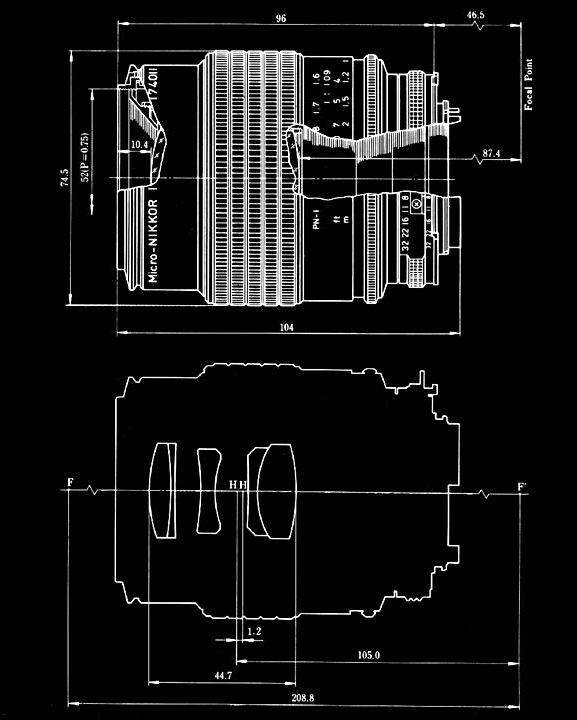
_________________
Camera (ˈkæ mə rə), n. Device for taking pictures in bright light
There are 10 kinds of people in the world: those who understand binary, and those who don’t. Key: Ai-P, Ai, Ai'ed, AiS
Camera: Nikon D90, D40, DK-21M eyepiece, ML-3 remote MF lenses: Nikkor 20mm f/4 K, AI'ed | N.K. Nikkor-N 24mm f/2.8 | Nikkor-N.C 24mm f/2.8 | Nikkor 28mm f/2.8 AiS late model | Арсенал (Arsenal) Мир-24Н (Mir-24N) 35mm f/2 | Cosina Voigtländer Ultron SL II 40mm f/2.0 | Micro-Nikkor 55mm f/2.8 AiS | Zoom-Nikkor 80-200 f/4.5 Ai | ЛЗОС (LZOS) Юпитер-9 (Jupiter-9) 85mm f/2 | Cosina Voigtländer APO-Lanthar 90mm f/3.5 SL | Nikkor-P 105mm f/2.5 pre-Ai, Ai'ed | Micro-Nikkor 105mm f/4 | Schneider Kreuznach Componon 105mm f/5.6 | Nikkor 135mm f/2.8, Ai'ed 1976 model | Nikkor 180mm f/2.8 ED AiS | Арсенал (Arsenal) ТЕЛЕАР-Н (Telear-n) 200mm f/3.5 | Nikkor 300 mm f/4.5 Ai (full equipment list) |
|
| Back to top |
|
 |
no-X


Joined: 19 Jul 2008
Posts: 2495
Location: Budejky, Czech Republic
|
 Posted: Sun Dec 06, 2009 6:26 pm Post subject: Posted: Sun Dec 06, 2009 6:26 pm Post subject: |
 |
|
no-X wrote:
| ChrisLilley wrote: |
| no-X wrote: |
| In this case I think it isn't possible to place it in any of these group. It's kind of "floating" desing (I don't know the exact term which should be used for this type of construction) like the Macro 125/2.5... |
No, nothing floats. All optical elements move forwards, by the same amount, as you focus closer. That's what I meant by "unit focusing". This is also shown by the fact that the focal length at closest focus is the same as at infinity. |
Sorry, my bad. It could be (tele-)ultron then 
Spotmatic: This komura is already present in Primoplan category (Primoplan is version of Ernostar with doublet instead of 2nd element).
ChrisLilley: The Micro Nikkor is Heliar (Heliar is 2-1-2)
Relayer: The Tamron 200/3.5 reminds me some Takumars/Pentax lenses. It doesn't fit to any category - it's quite modified Ernostar
The 135/3.2 Hexanon is similar to some Nikkors. It's Ernostar-based, but i have no category for this particular version.
As for the Fujinons: I'd add the 100/2.8 to enhanced Ernostar category. Orientation of the reat doublet likely doesn't change a much, I've seen many patents showing both positions are possible - results should be very similar.
55/2.2 - 4 elements in 4 groups - I think it could be basic Ernostar. I'm not sure if simple gauss configuration using only 4 elements could be that fast (and perform acceptably).
_________________
(almost) complete list of Helios lenses |
|
| Back to top |
|
 |
|
|
